Saw-whet Science with the Harris Center
In the fall of 2022, the Harris Center launched a pilot season of Northern Saw-whet Owl (Aegolius acadicus) banding on SuperSanctuary lands, as part of an international research effort (projectowlnet.org) to better understand the fall migration of this charismatic bird of prey.
Why Band Northern Saw-Whet Owls?
Saw-whet owls are small, secretive, and nocturnal, which can make them difficult to study. In addition, although they are currently common, they may be vulnerable to climate change; unless additional climate action is taken, the National Audubon Society predicts a 72% loss in their summer range — including the entire Granite State — by 2080. Banding is one of the best tools we have for monitoring changes in saw-whet populations and migration patterns over time, and for identifying critical migration routes and overwintering habitat. Although saw-whet owl banding stations exist in Maine, Vermont, and Massachusetts, ours is the only such project in New Hampshire at this time.
Banding offers a rare opportunity for close-up looks at these charistmatic birds of prey. (photo © Phil Stollsteimer)
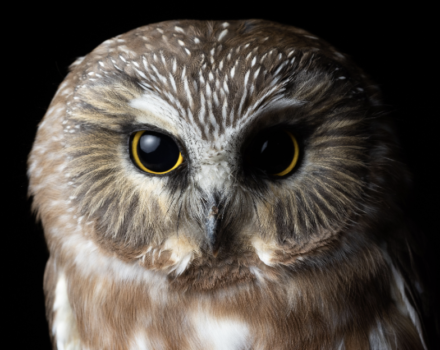
Lead Bander Hillary Siener measures the wing chord on a saw-whet owl. (photo © Brett Amy Thelen)
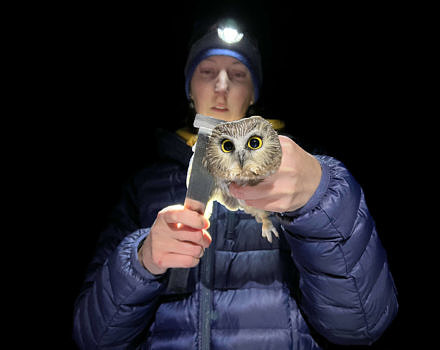
Methods
Banding took place at three different sites on Harris Center lands, which were selected based on land ownership, forest cover, slope, access, and distance from residential areas. At each site, researchers set up a temporary array of fine “mist nets” and played an audio loop of a saw-whet owl call to lure owls toward the nets. The nets were checked every 20 to 40 minutes, and owls were carefully removed by trained individuals. Each owl was then weighed, measured, examined to determine age and sex, and outfitted with a lightweight metal USGS band containing a unique number before being released back to the wild. The safety of the owls was our top priority.
All banding was conducted according to protocols established by Project Owlnet, under the leadership of experienced owl bander Hillary Siener. Hillary operated the station as a sub-permittee under Dr. Jon Atwood’s master banding permit from the USGS Bird Banding Lab, and in accordance with a scientific permit from NH Fish and Game.
Staff and volunteers carefully remove a saw-whet owl from a mist net. (photo © Brett Amy Thelen)
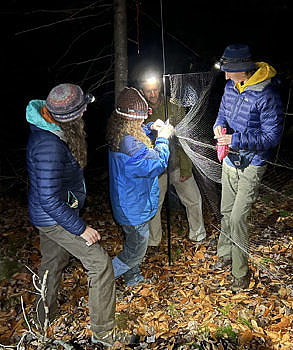
After they were removed from the mist nests, owls were placed into cloth bags to keep them calm. (photo © Brett Amy Thelen)
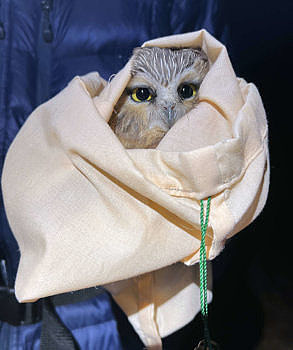
Staff and volunteers assist lead bander Hillary Siener with data entry and band preparation at the banding table. (photo © Phil Brown)
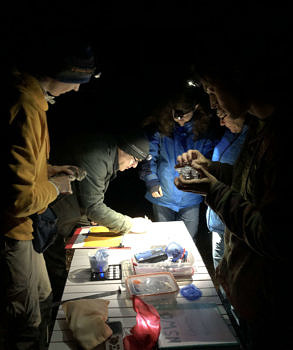
Initial Findings
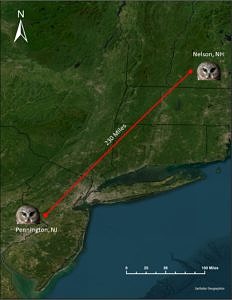
A map showing the approximate distance traveled by a saw-whet owl that was banded in Nelson, NH on October 27, 2022 and encountered again at a banding station in Pennington, NJ on November 19, 2022. Click on the image for a larger view.
(map © Will Stollsteimer)
Over the course of 25 nights from September 30 to November 19, our team banded 53 saw-whet owls. Migration peaked the week of October 23 to October 29; 45 percent of all captures occurred during this one week, including 15 owls on the night of October 27. 46 of the 53 owls (87%) were female, 4 (7%) were males, and 3 (6%) were of undetermined sex. The majority of owls were hatch-year (64%) or second-year (15%) birds.
One owl banded in Nelson on the peak migration night of October 27 was encountered at another banding station in Pennington, New Jersey on November 19. On average, this bird traveled 9.6 miles/night between the two trapping sites, covering a distance of approximately 230 miles in just over three weeks.
Education & Outreach
Saw-whet owls are truly awww-inspiring and banding efforts – which offer the rare opportunity to see owls up-close – hold incredible potential for connecting people to the natural world. Although this season’s banding efforts were primarily aimed at training staff and volunteers, we did offer two educational owl banding demonstrations: one on October 28 through the Harris Center’s public calendar of events, and another on November 2 for a small group of students and teachers from the Dublin School. We hope to offer more opportunities for the public to observe saw-whet science in action in the fall of 2023.
Each owl was weighed, measured, examined to determine age and sex, and outfitted with a lightweight metal USGS band containing a unique number before being released back to the wild. (photo © Brett Amy Thelen)
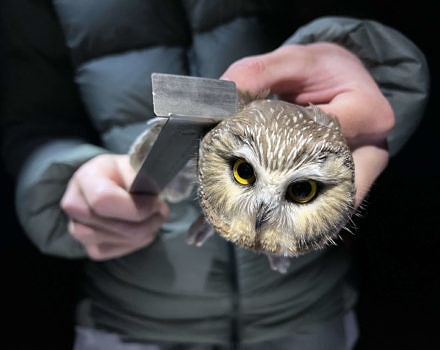
35 visitors got up-close looks at saw-whet owls over the course of two banding demonstrations in 2022. (photo © Brett Amy Thelen)

Acknowledgments
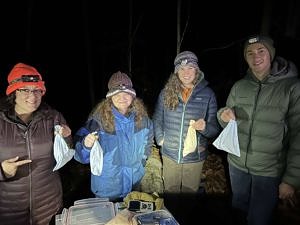
Staff and volunteers holding saw-whet owls in bags on the “big owl night” of October 27. From left to right: Brett Amy Thelen, Annamarie Saenger, Julie Brown, and Will Stollsteimer. (photo © Brett Amy Thelen)
Volunteers are critical to the work accomplished by the Harris Center, and this project would not have been possible without the hard work, late nights, and dedication of volunteers Jon Atwood, Julie Brown, Russ Cobb, Steven Lamonde, Cynthia Nichols, Annamarie Saenger, Cliff Seifer, and Kim Snyder. In addition, Harris Center staff members Phil Brown, Karen Seaver, Hillary Siener, Susie Spikol, Will Stollsteimer, and Brett Amy Thelen helped with planning, research, communications, grant and permit applications, budget preparations, data entry and report writing, site selection and setup, nightly operations at the banding sites, and more.
Together, staff and volunteers contributed more than 600 hours to the project in 2022. Thanks to all for their many hours of hard work behind the scenes and at the banding sites, and for all the enjoyable conversations on brisk evenings under starry skies…
This project was made possible with support from the Harris Center’s 50th Anniversary Fund.
Contact Us
For more information on the Harris Center’s saw-whet owl banding efforts, please contact Bird Conservation Director Phil Brown by email.

